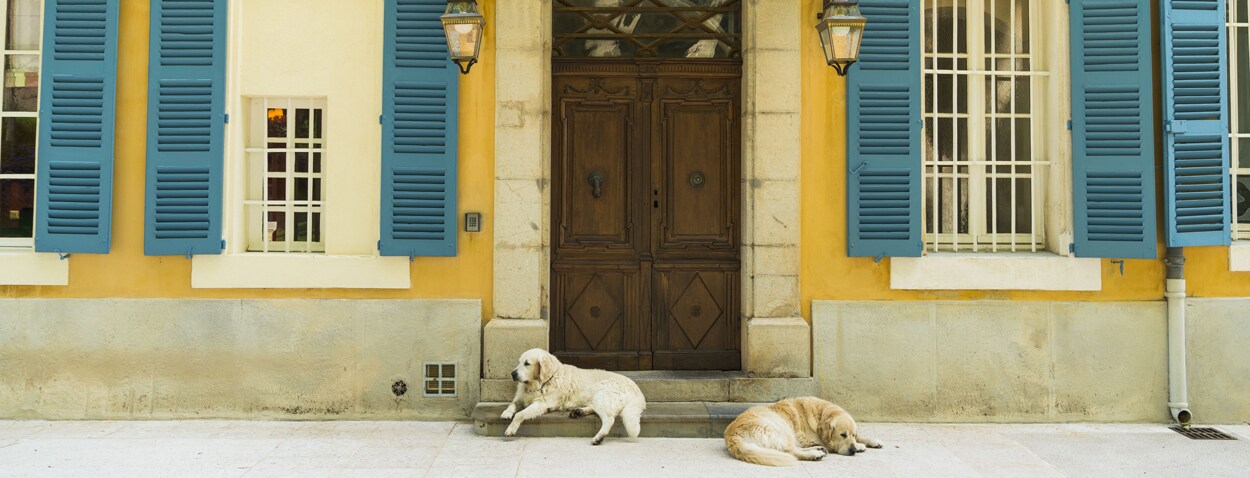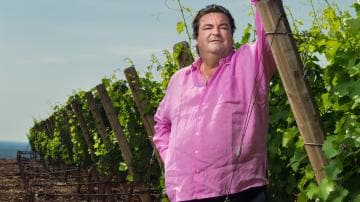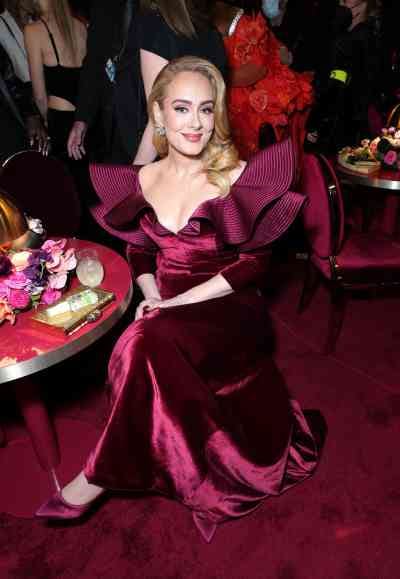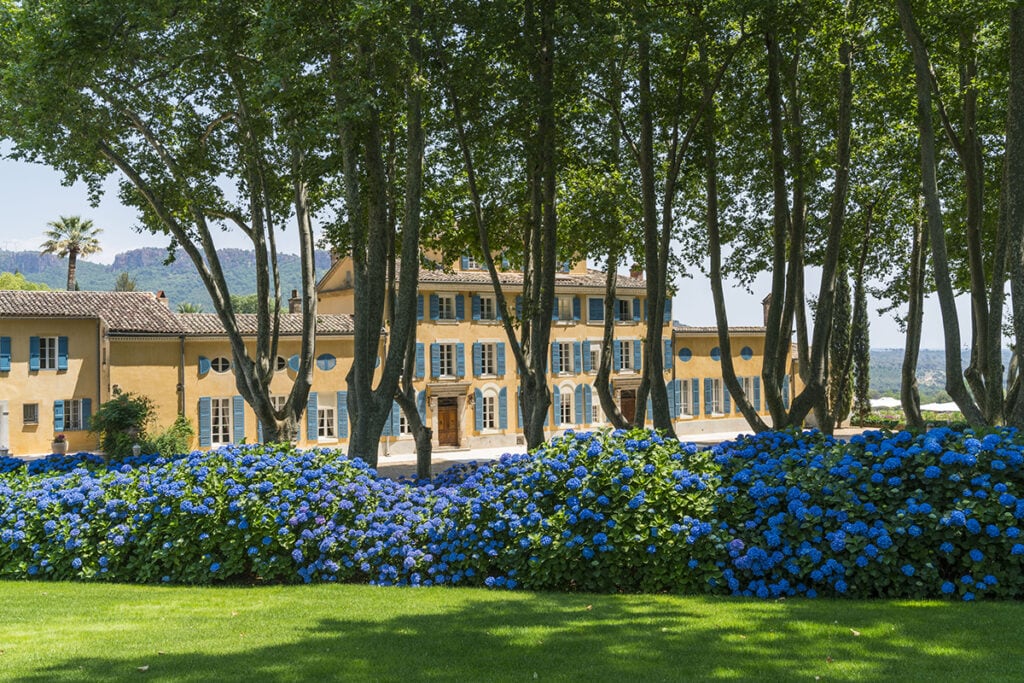The Times of London


How Whispering Angel became the world’s favourite posh rosé
Experts laughed at Sacha Lichine when he launched an expensive rosé — nobody in the wine world, they said, would take it seriously. Now his Whispering Angel, loved by A-listers like Adele and Victoria Beckham, shifts one million cases a year
By Hilary Rose

ANDREI KOVALEV
If you drive along the coast road from Nice, turn inland at St Tropez and keep going for half an hour, you’ll see big white letters tacked onto the hill. It’s like the Hollywood sign but reads DOMAINE SACHA LICHINE. If you go into the discreet little shop opposite, through the grand gateposts with cockerels on top, you’ll find a lifesize pink camel painted with the advice, “Save water: drink rosé.” And if you walk a little further down the gravel track, where you’re not allowed to go, you’ll find a Provençal dream house glowing pinky apricot in the sunshine, looking down a valley of vineyards and pine trees towards the Med. This is Château d’Esclans, or more accurately Château Whispering Angel, and if you’ve ever hankered after a cold glass of rosé on a hot day, this place is why.
Inside, le patron, Monsieur Lichine, is reclining on a vast sofa in a vast room. He has a glass of rosé in one hand, a cigarette in the other and a chef in the kitchen preparing French classics for dinner, heady with butter and cream. Lichine gambled 20 years ago that rosé was overdue for an upgrade and set about doing it. Now 62, he’s an astute businessman and passionate salesman with the languid air of a bon viveur. Our conversation is punctuated by the gentle glug of glasses being topped up by silent, uniformed staff and by the ringtone of his phone — which is Shaggy, singing, “Girl, you’re my angel, you’re my darling angel.”
“Rosé was seen as cheap and cheerful and it gave you a headache on holiday in St Tropez,” he says, flicking his cigarette into an ashtray the shape of a bunch of grapes. “It was a day drink, a lot of it was quite sweet and it wasn’t seen as ‘real’ wine. It’s the hardest wine to make good and the easiest to make average, so I said let’s see if we can make rosé great. I wanted a challenge. And bit by bit, the category started to boom.”
Today, one million cases of Whispering Angel are sold annually in 106 countries around the world. According to the Council of Wines of Provence (CIVP), the price of rosé has risen by 29 per cent since 2015 and global consumption by nearly a quarter since 2002. In 2019, Forbes reported that since 2010, sales by volume of rosé in the US had increased by more than 1,400 per cent. Lichine says that since 2006, the price of a hectolitre of Provençal rosé has nearly quadrupled, “so it’s worked out quite well for everybody in the region. We’ve made it into serious wine.” So serious that three years ago he sold a controlling stake to the luxury goods conglomerate LVMH, where it joins Krug and Dom Pérignon. Bernard Arnault, the head of LVMH, likes to drink it when he’s visiting Lichine, and evidently doesn’t care, unlike some of his compatriots, that a French wine made by a Frenchman has an English name.
The name came about by chance, when Lichine was in the chapel at d’Esclans one night with a friend. They were admiring a sculpture carved above the altar of two cherubs, and the friend said it looked as if they were whispering to each other. A delicate line drawing of the whispering angels is now on the label, and two of those bottles stand in niches high up on the nave. Some visitors complain that it’s sacrilege.
Lichine bought d’Esclans in 2006 and people in the wine industry told him he was mad. Nobody took rosé seriously, they protested. It wasn’t a proper “category” of wine and never would be. No customer would pay good money for it, no critic would endorse it and no sommelier would touch it. But he had a hunch, based on the burgeoning success of pink champagne, that if people were willing to pay top whack for sparkly pink, then why not pink wine?
“They said I was totally out of my mind,” he says equably. “They wouldn’t even talk to me. They said he’s crazy, he’s smoking too much pot.”
In the beginning, money was tight. He spent it on establishing the vineyard and making the wine, not advertising, which he thinks is “a little cheap”. Better, he thought, to spend that money flying him round the world trying to sell it. Last on the list was doing up the run-down château bit by bit, as the “face” of the brand. Word of mouth, celebrity endorsement and social media did the rest. “It obviously has importance,” he sniffs about social media, “but I’ve never really been able to quantify it.”
Easier to quantify is the time Adele told Vogue that the two things she bought at the supermarket during Covid were Heinz tomato ketchup and Whispering Angel. Or Victoria Beckham going public with her penchant for Garrus, WA’s posh and expensive sibling, ever since d’Esclans sent her two cases when she was staying up the road with Elton John. Sarah Ferguson comes to d’Esclans to pay her respects when she’s staying at a friend’s château nearby. She and her daughters, Princesses Beatrice and Eugenie, like WA so much that they sent Lichine a pair of angel wings as a thank you. They sit on a desk in the salon, beneath a stuffed moose’s head and across from a downstairs loo handpainted with flamingos to look like the Beverly Hills Hotel. It did the branding no harm when in 2019 Malia Obama was photographed drinking WA by a pool in Miami even though, at 20, she was still under age, or that the New York Post declared an emergency rosé shortage in the Hamptons in 2013: two women were photographed fighting over the last case of Whispering Angel. That was the year that Lichine realised his gamble had paid off.

GETTY IMAGES
He was born in Bordeaux, the son of Alexis, a Russian émigré who is credited with introducing French wine to America. Père Lichine owned one château, Prieuré-Lichine, and had shares in others. The young Sacha was raised in New York and educated in New England, but spent summers back in France, working in the vineyards. He was five when he had his first glass of wine, a Château Lascombes, he recalls. There was never any question as to what he would do for a living.
“I loved it from the start. I learnt to drive a tractor before I learnt to drive a car. I was in the vineyards, in the cellar, putting nails into wooden cases… The fact that I grew up around wine gave me a passion for it.”
He dropped out of Boston University because he was making a fortune in the Caribbean as an agent for a champagne house, and spent his twenties working his way around the wine industry: distribution in New England, retail in New York, a stint as a sommelier in a restaurant in Boston. He fell in love with a soap actress and moved to Los Angeles.
“My father was livid. He said, ‘You’re an idiot,’ and he wasn’t wrong.” The actress dumped him two weeks later. Living in LA without being in the movie business was, he discovered, like living in Bordeaux and not being in the wine business. At that point, when he was 27, fate intervened in the form of his father’s lawyer, who summoned him back to Bordeaux to run the family business. Eighteen months later his father died and, ten years after that, he sold up to pay off his inherited debts and fund his Provençal dream. It wasn’t a difficult decision, because he was sick and tired of the rain.
“I wanted a little more excitement; to do something newer. I wasn’t into just managing an operation. It was merely a price game.”

SARA MATTHEWS
D’Esclans, he thought, was the most beautiful chateau he had ever seen. The bank wouldn’t give him a €100,000 overdraft, but he reached a deal with the makers of Angostura Bitters, bought d’Esclans and told his friend and collaborator, the Bordeaux wine maker Patrick Léon, to get on a plane. OK, said Léon, what’s the plan?
“I told him, ‘We’ll make something we want to drink. If we don’t like to drink it we can’t sell it, and if we want to sell it, we’re going to have to drink a lot of it.’ ”
They imported Bordeaux technology and know-how to an area where attitudes were a little more laissez-faire. You couldn’t charge much for a bottle of rosé, so it wasn’t worth investing money in making it. Lichine thought that he could charge a hell of a lot, but it took him ten years and $10 million to prove it. Back in 2006, as soon as the first vintage was ready, he hit the road with it. In Chicago.
“It’s very cold there and nobody drinks rosé,” he says, as if it’s the most obvious sales pitch in the world. “I figured if we could succeed there, we could succeed anywhere.”
His plan was to get his wine into the trendiest hotels, restaurants and bars, from the Delano in Miami to the Peninsula in New York, from Soho House to Chiltern Firehouse. Fine dining didn’t put it on the map, he says today; it was fun places, hot bistros and brasseries: the Polo Lounge, the Hotel Costes, the André Balazs group. He didn’t bang on the door of Michelin-starred restaurants and, besides, the sommelier probably would have slammed it in his face. Sommeliers can still be snooty about his rosé but then, he reasons, they didn’t become sommeliers to drink rosé; they did it for the grand crus.
He spent nine years trying and failing to get Club 55 in St Tropez to stock WA but had more luck on Mustique, the private island in the Caribbean where the super-rich and celebrities have villas. To get his brand noticed, he came up with the idea of striking a deal with the local baker, who delivered to all 82 of the villas on the island (he still knows exactly how many villas there are now). The baker was persuaded to deliver cases of Whispering Angel with the croissants, which got it noticed and drunk and talked about. But getting it to the point where it’s all over Instagram with its own hashtag took years. One buyer in Chicago told him that he couldn’t sell rosé, and if Lichine thought anyone would pay $100 for a bottle he was out of his mind. Lichine poured him a glass. “I can’t sell it,” the buyer said, “but I’ll take two cases for myself.”

Next up after Chicago was Nantucket, after which the Hamptons were his for the taking. Because he grew up around there, he knew that people in Nantucket thought they were a cut above people in the Hamptons, and people in the Hamptons tended to agree. If a smart hostess in Nantucket was serving Whispering Angel, then that’s what a smart hostess in the Hamptons wanted too. And it was invariably the women, at least at first. Men, he says, took longer to take it seriously.
Over the next few years, Lichine, his second wife and their three children moved from Chicago to Hong Kong, Singapore, Boston, Miami and finally back to France, where there was an urgent problem: they couldn’t keep up with demand. Naysayers sniff that they solved it by buying in grapes from other vineyards; customers don’t care and Lichine is laughing all the way to LVMH. He makes seven wines now, ranging from the Pale for around £15 to Garrus at more than £100, produced from the 100-year-old vines on the estate. There’s more competition now, not least from Miraval. Brad Pitt and Angelina Jolie bought the château when they were married and fought over it when they divorced, but Pitt was canny, says Lichine. He brought in “real” wine people to help him make the wine, when he could just have lain by the pool and counted the money. It would still have sold, he says. Or at least the first time.
Today, he spends five months a year at d’Esclans and much of the rest of it on the road. When someone else can sell it better than he can, he’ll retire. Until then the family base is Gstaad, and his wife doesn’t mind his prolonged absences. Does she like rosé? “She’d better!” He takes a sip of his pale pink drink, and we contemplate the giant nine-litre bottles of pale pink wine lining the pale pink bar of his pale pink chateau.
“There’s a lot of rosé being produced in the world,” he says, taking a canapé from a passing tray, “but Provence rosé is better than most. There are still quite a few snooty sommeliers and dealers, and it’s still a battle, but is it a fad? I don’t think so. Rosé is here to stay.”
‘Bonkers price’: the age of the £100 rosé
Wine critic Jane MacQuitty picks the top pinks. Start saving now…
2021 Les Clans, Château d’Esclans, Côtes de Provence (14 per cent)
thefinestbubble.com, £68
Those who can afford Sacha Lichine’s vanilla pod, candied and wood smoke-scented posh pink won’t be disappointed.
2020 Garrus, Château d’Esclans, Côtes de Provence (14 per cent)
Majestic, £139.99
Shocking price but a sensational rosé made from 80-year-old vines, aged and fermented in oak, with dreamy, tobacco-leaf fruit.






